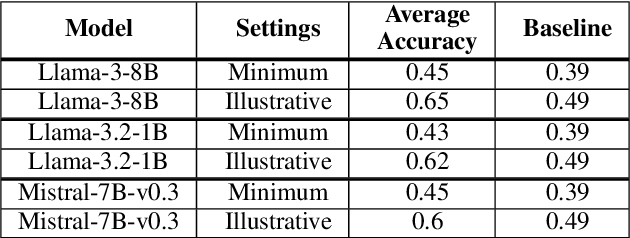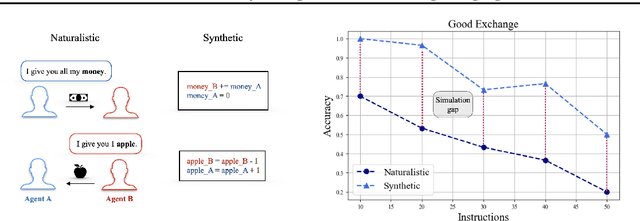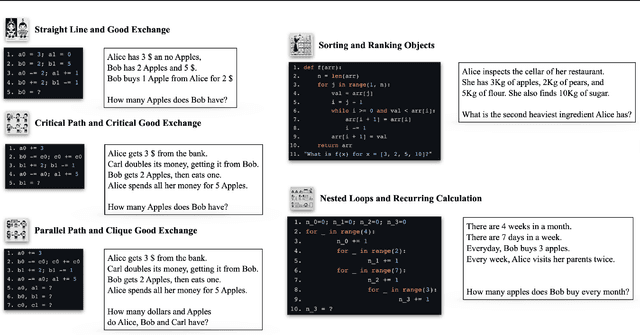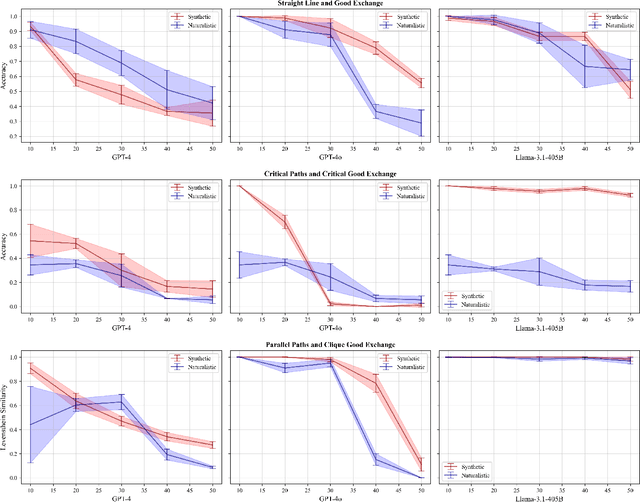Michael Wooldridge
University of Oxford
An End-to-end Planning Framework with Agentic LLMs and PDDL
Dec 10, 2025Abstract:We present an end-to-end framework for planning supported by verifiers. An orchestrator receives a human specification written in natural language and converts it into a PDDL (Planning Domain Definition Language) model, where the domain and problem are iteratively refined by sub-modules (agents) to address common planning requirements, such as time constraints and optimality, as well as ambiguities and contradictions that may exist in the human specification. The validated domain and problem are then passed to an external planning engine to generate a plan. The orchestrator and agents are powered by Large Language Models (LLMs) and require no human intervention at any stage of the process. Finally, a module translates the final plan back into natural language to improve human readability while maintaining the correctness of each step. We demonstrate the flexibility and effectiveness of our framework across various domains and tasks, including the Google NaturalPlan benchmark and PlanBench, as well as planning problems like Blocksworld and the Tower of Hanoi (where LLMs are known to struggle even with small instances). Our framework can be integrated with any PDDL planning engine and validator (such as Fast Downward, LPG, POPF, VAL, and uVAL, which we have tested) and represents a significant step toward end-to-end planning aided by LLMs.
Using causal abstractions to accelerate decision-making in complex bandit problems
Sep 04, 2025Abstract:Although real-world decision-making problems can often be encoded as causal multi-armed bandits (CMABs) at different levels of abstraction, a general methodology exploiting the information and computational advantages of each abstraction level is missing. In this paper, we propose AT-UCB, an algorithm which efficiently exploits shared information between CMAB problem instances defined at different levels of abstraction. More specifically, AT-UCB leverages causal abstraction (CA) theory to explore within a cheap-to-simulate and coarse-grained CMAB instance, before employing the traditional upper confidence bound (UCB) algorithm on a restricted set of potentially optimal actions in the CMAB of interest, leading to significant reductions in cumulative regret when compared to the classical UCB algorithm. We illustrate the advantages of AT-UCB theoretically, through a novel upper bound on the cumulative regret, and empirically, by applying AT-UCB to epidemiological simulators with varying resolution and computational cost.
Automatic Differentiation of Agent-Based Models
Sep 03, 2025Abstract:Agent-based models (ABMs) simulate complex systems by capturing the bottom-up interactions of individual agents comprising the system. Many complex systems of interest, such as epidemics or financial markets, involve thousands or even millions of agents. Consequently, ABMs often become computationally demanding and rely on the calibration of numerous free parameters, which has significantly hindered their widespread adoption. In this paper, we demonstrate that automatic differentiation (AD) techniques can effectively alleviate these computational burdens. By applying AD to ABMs, the gradients of the simulator become readily available, greatly facilitating essential tasks such as calibration and sensitivity analysis. Specifically, we show how AD enables variational inference (VI) techniques for efficient parameter calibration. Our experiments demonstrate substantial performance improvements and computational savings using VI on three prominent ABMs: Axtell's model of firms; Sugarscape; and the SIR epidemiological model. Our approach thus significantly enhances the practicality and scalability of ABMs for studying complex systems.
Emergent Risk Awareness in Rational Agents under Resource Constraints
May 29, 2025Abstract:Advanced reasoning models with agentic capabilities (AI agents) are deployed to interact with humans and to solve sequential decision-making problems under (approximate) utility functions and internal models. When such problems have resource or failure constraints where action sequences may be forcibly terminated once resources are exhausted, agents face implicit trade-offs that reshape their utility-driven (rational) behaviour. Additionally, since these agents are typically commissioned by a human principal to act on their behalf, asymmetries in constraint exposure can give rise to previously unanticipated misalignment between human objectives and agent incentives. We formalise this setting through a survival bandit framework, provide theoretical and empirical results that quantify the impact of survival-driven preference shifts, identify conditions under which misalignment emerges and propose mechanisms to mitigate the emergence of risk-seeking or risk-averse behaviours. As a result, this work aims to increase understanding and interpretability of emergent behaviours of AI agents operating under such survival pressure, and offer guidelines for safely deploying such AI systems in critical resource-limited environments.
Large Language Models Miss the Multi-Agent Mark
May 27, 2025Abstract:Recent interest in Multi-Agent Systems of Large Language Models (MAS LLMs) has led to an increase in frameworks leveraging multiple LLMs to tackle complex tasks. However, much of this literature appropriates the terminology of MAS without engaging with its foundational principles. In this position paper, we highlight critical discrepancies between MAS theory and current MAS LLMs implementations, focusing on four key areas: the social aspect of agency, environment design, coordination and communication protocols, and measuring emergent behaviours. Our position is that many MAS LLMs lack multi-agent characteristics such as autonomy, social interaction, and structured environments, and often rely on oversimplified, LLM-centric architectures. The field may slow down and lose traction by revisiting problems the MAS literature has already addressed. Therefore, we systematically analyse this issue and outline associated research opportunities; we advocate for better integrating established MAS concepts and more precise terminology to avoid mischaracterisation and missed opportunities.
Fixed Point Explainability
May 18, 2025



Abstract:This paper introduces a formal notion of fixed point explanations, inspired by the "why regress" principle, to assess, through recursive applications, the stability of the interplay between a model and its explainer. Fixed point explanations satisfy properties like minimality, stability, and faithfulness, revealing hidden model behaviours and explanatory weaknesses. We define convergence conditions for several classes of explainers, from feature-based to mechanistic tools like Sparse AutoEncoders, and we report quantitative and qualitative results.
Language Models Are Implicitly Continuous
Apr 04, 2025Abstract:Language is typically modelled with discrete sequences. However, the most successful approaches to language modelling, namely neural networks, are continuous and smooth function approximators. In this work, we show that Transformer-based language models implicitly learn to represent sentences as continuous-time functions defined over a continuous input space. This phenomenon occurs in most state-of-the-art Large Language Models (LLMs), including Llama2, Llama3, Phi3, Gemma, Gemma2, and Mistral, and suggests that LLMs reason about language in ways that fundamentally differ from humans. Our work formally extends Transformers to capture the nuances of time and space continuity in both input and output space. Our results challenge the traditional interpretation of how LLMs understand language, with several linguistic and engineering implications.
Understanding the Logical Capabilities of Large Language Models via Out-of-Context Representation Learning
Mar 13, 2025



Abstract:We study the capabilities of Large Language Models (LLM) on binary relations, a ubiquitous concept in math employed in most reasoning, math and logic benchmarks. This work focuses on equality, inequality, and inclusion, along with the properties they satisfy, such as ir/reflexivity, a/symmetry, transitivity, and logical complexity (e.g., number of reasoning ``hops''). We propose an alternative to in-context learning that trains only the representations of newly introduced tokens, namely out-of-context representation learning. This method mitigates linguistic biases already present in a model and, differently from in-context learning, does not rely on external information or illustrations. We argue out-of-context representation learning as a better alternative to in-context learning and fine-tuning to evaluate the capabilities of LLMs on logic tasks that are the building blocks of more complex reasoning benchmarks.
Code Simulation as a Proxy for High-order Tasks in Large Language Models
Feb 05, 2025



Abstract:Many reasoning, planning, and problem-solving tasks share an intrinsic algorithmic nature: correctly simulating each step is a sufficient condition to solve them correctly. We collect pairs of naturalistic and synthetic reasoning tasks to assess the capabilities of Large Language Models (LLM). While naturalistic tasks often require careful human handcrafting, we show that synthetic data is, in many cases, a good proxy that is much easier to collect at scale. We leverage common constructs in programming as the counterpart of the building blocks of naturalistic reasoning tasks, such as straight-line programs, code that contains critical paths, and approximate and redundant instructions. We further assess the capabilities of LLMs on sorting problems and repeated operations via sorting algorithms and nested loops. Our synthetic datasets further reveal that while the most powerful LLMs exhibit relatively strong execution capabilities, the process is fragile: it is negatively affected by memorisation and seems to rely heavily on pattern recognition. Our contribution builds upon synthetically testing the reasoning capabilities of LLMs as a scalable complement to handcrafted human-annotated problems.
Jailbreaking Large Language Models in Infinitely Many Ways
Jan 18, 2025Abstract:We discuss the "Infinitely Many Meanings" attacks (IMM), a category of jailbreaks that leverages the increasing capabilities of a model to handle paraphrases and encoded communications to bypass their defensive mechanisms. IMMs' viability pairs and grows with a model's capabilities to handle and bind the semantics of simple mappings between tokens and work extremely well in practice, posing a concrete threat to the users of the most powerful LLMs in commerce. We show how one can bypass the safeguards of the most powerful open- and closed-source LLMs and generate content that explicitly violates their safety policies. One can protect against IMMs by improving the guardrails and making them scale with the LLMs' capabilities. For two categories of attacks that are straightforward to implement, i.e., bijection and encoding, we discuss two defensive strategies, one in token and the other in embedding space. We conclude with some research questions we believe should be prioritised to enhance the defensive mechanisms of LLMs and our understanding of their safety.
 Add to Chrome
Add to Chrome Add to Firefox
Add to Firefox Add to Edge
Add to Edge